Researchers of RIKEN at Japan’s synchrotron radiation facility, SPring-8 and their collaborators have developed a faster and simpler way to carry out segmentation analysis, a vital process in materials science. The new method was published in the journal Science and Technology of Advanced Materials: Methods.
Segmentation analysis is used to understand the fine-scale composition of a material. It identifies distinct regions (or ‘segments’) with specific compositions, structural characteristics, or properties. This helps evaluate the suitability of a material for specific functions, as well as its possible limitations. It can also be used for quality control in material fabrication and for identifying points of weakness when analyzing materials that have failed.
Segmentation analysis is very important for synchrotron radiation X-ray computed tomography (SR-CT), which is similar to conventional medical CT scanning but uses intense focused X-rays produced by electrons circulating in a storage ring at nearly the speed of light.
The team have demonstrated that machine learning is capable in conducting the segmentation analysis for the refraction contrast CT, which is especially useful for visualizing the three-dimensional structure in samples with small density differences between regions of interest, such as epoxy resins.
“Until now, no general segmentation analysis method for synchrotron radiation refraction contrast CT has been reported,” says first author Satoru Hamamoto. “Researchers have generally had to do segmentation analysis by trial and error, which has made it difficult for those who are not experts.”
The team’s solution was to use machine learning methods established in biomedical fields in combination with a transfer learning technique to finely adjust to the segmentation analysis of SR-CTs. Building on the existing machine learning model greatly reduced the amount of training data needed to get results.
“We’ve demonstrated that fast and accurate segmentation analysis is possible using machine learning methods, at a reasonable computational cost, and in a way that should allow non-experts to achieve levels of accuracy similar to experts,” says Takaki Hatsui, who led the research group.
The researchers carried out a proof-of-concept analysis in which they successfully detected regions created by water within an epoxy resin. Their success suggests that the technique will be useful for analyzing a wide range of materials.
To make this analysis method available as widely and quickly as possible, the team plans to establish segmentation analysis as a service offered to external researchers by the SPring-8 data center, which has recently started its operation.
More information:
Satoru Hamamoto et al, Demonstration of efficient transfer learning in segmentation problem in synchrotron radiation X-ray CT data for epoxy resin, Science and Technology of Advanced Materials: Methods (2023). DOI: 10.1080/27660400.2023.2270529
Citation:
Machine learning techniques improve X-ray materials analysis (2023, November 16)
retrieved 16 November 2023
from https://phys.org/news/2023-11-machine-techniques-x-ray-materials-analysis.html
This document is subject to copyright. Apart from any fair dealing for the purpose of private study or research, no
part may be reproduced without the written permission. The content is provided for information purposes only.
Denial of responsibility! TechCodex is an automatic aggregator of the all world’s media. In each content, the hyperlink to the primary source is specified. All trademarks belong to their rightful owners, and all materials to their authors. For any complaint, please reach us at – [email protected]. We will take necessary action within 24 hours.

Jessica Irvine is a tech enthusiast specializing in gadgets. From smart home devices to cutting-edge electronics, Jessica explores the world of consumer tech, offering readers comprehensive reviews, hands-on experiences, and expert insights into the coolest and most innovative gadgets on the market.


